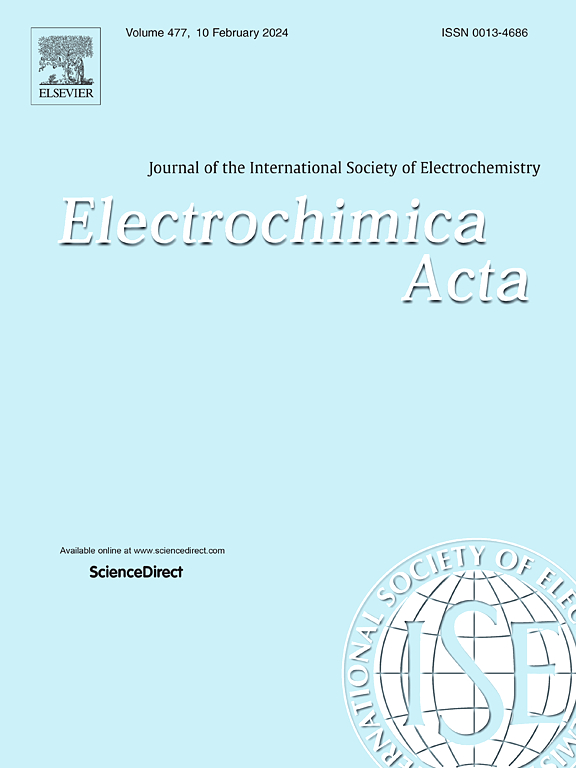由氧化铜纳米球-多壁碳纳米管制备的新型电化学探针用于检测环境和药物基质中的伐昔洛韦
IF 5.6
3区 材料科学
Q1 ELECTROCHEMISTRY
引用次数: 0
摘要
全球对副作用最小的抗病毒药物的需求不断增长,永远是预防感染的先锋。虽然盐酸瓦昔洛韦(VCV)是一种安全的抗病毒药物,但如果滥用,不仅会对患者的身体造成严重的副作用,还会对环境造成严重的影响。为了优化VCV的效价,建立了一种新的电化学方法来快速有效地检测环境水和患者生物体液中VCV的残留。在此,通过将氧化铜纳米球(Cu2O NBs)直接修饰在多壁碳纳米管(MWCNT)修饰的玻碳电极(GCEs)上,制备了vcv高灵敏度平台。Cu2O铌和MWCNT相结合,增强电传感能力。氧化铜为表面相互作用创造了许多活性位点,而碳纳米管为电子传递建立了有效的途径。这种组合通过增强的电子导电性、丰富的活性位点和广泛的表面积提高了检测灵敏度。制备的Cu2O/MWCNT/GCE探针具有快速的响应时间和显著的选择性,可在0.5 ~ 65 μM的广泛浓度范围内精确跟踪VCV。Cu2O/MWCNT/GCE探针的灵敏度为0.61 μA μM−1,准确度范围广,重复性好,检出限低(0.16 μM),适合在接近生理pH条件下检测vcv水平。因此,精确的Cu2O/MWCNT/GCE传感探针不仅可以追踪人体生物体液中的VCV,还可以在没有样品预处理的情况下追踪环境(河流/地下水)和药物中的VCV。本文章由计算机程序翻译,如有差异,请以英文原文为准。


A novel electrochemical probe crafted from copper oxide nanoball-multiwalled carbon nanotube for valacyclovir detection in environmental and medicinal matrices
Growing global demand for antivirals with minimised adverse effects is eternally at the vanguard of infections. Although valacyclovir hydrochloride (VCV) is a safe antiviral, it may lead to dire side effects not only on the patients’ bodies but also on the environment if misused. Due attention is paid to optimizing the potency of the VCV, a novel electrochemical approach has been generated for fast and efficient detection of VCV’s residue in environmental water and patients' biofluids. Herein, VCV-highly sensitive platforms were crafted through direct decoration of copper oxide nanoballs (Cu2O NBs) onto multiwalled carbon nanotube (MWCNT)-modified glassy carbon electrodes (GCEs). Cu2O NBs and MWCNT combine to enhance electrical sensing capabilities. The copper oxide creates numerous active sites for surface interactions, while carbon nanotubes establish efficient pathways for electron transport. This combination improves detection sensitivity through enhanced electronic conductivity, abundant active sites, and extensive surface area. With expeditious response time and remarkable selectiveness, the fabricated Cu2O/MWCNT/GCE probes were accurately traceable VCV within a broad range of concentrations from 0.5 to 65 μM. Parallel to a wide range of accuracy with proper sensitivity of 0.61 μA μM−1, while benefiting from notable reproducibility and low detection limit (0.16 μM), Cu2O/MWCNT/GCE probes are propitious for VCV-level detection in near-physiological pH conditions. Consequently, the precise Cu2O/MWCNT/GCE sensing probes are up to trace VCV in not only human biofluids, but also environmental (river/ground waters) and pharmaceuticals with no sample pre-treatment.
求助全文
通过发布文献求助,成功后即可免费获取论文全文。
去求助
来源期刊

Electrochimica Acta
工程技术-电化学
CiteScore
11.30
自引率
6.10%
发文量
1634
审稿时长
41 days
期刊介绍:
Electrochimica Acta is an international journal. It is intended for the publication of both original work and reviews in the field of electrochemistry. Electrochemistry should be interpreted to mean any of the research fields covered by the Divisions of the International Society of Electrochemistry listed below, as well as emerging scientific domains covered by ISE New Topics Committee.
 求助内容:
求助内容: 应助结果提醒方式:
应助结果提醒方式:


